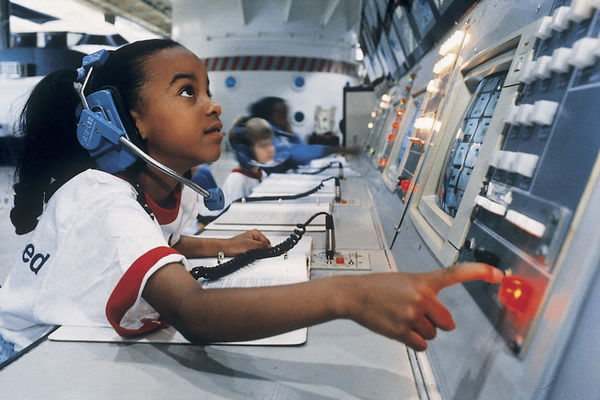Attend space camp
Attend a hands on space camp to build a model rocket, simulate astronaut exercises, and learn about planets, rockets, and teamwork.



Step-by-step guide to attend a hands-on space camp
CTC College for Kids: Junior Space Camp
Step 1
Gather all the materials and put them on a clear table so your space camp is ready.
Step 2
Ask a friend or family member to be your teammate for space camp.
Step 3
Use markers to decorate the paper tube so it looks like a rocket body.
Step 4
Cut a circle from paper and fold it into a cone to make the rocket nose.
Step 5
Tape the cone to the top of your decorated rocket tube.
Step 6
Cut out three fins from paper and attach them to the bottom of the rocket with tape.
Step 7
Tie a long piece of string tightly between two chairs across the room to make a launch line.
Step 8
Thread a straw onto the string so the straw can slide freely along the line.
Step 9
Inflate a balloon partway and pinch the end closed without tying it.
Step 10
Tape the inflated balloon to the straw so the balloon will push the straw when released.
Step 11
Tape your paper rocket to the straw next to the balloon so it will travel with the straw.
Step 12
Let go of the balloon and watch your rocket zoom along the string during launch.
Step 13
Create a short astronaut training course with pillows blankets and cushions for crawling balancing and jumping.
Step 14
Complete the astronaut training course with your teammate as a relay to practice teamwork.
Step 15
Pick three planets and say one fun fact about each then share a photo or short video of your rocket and teamwork on DIY.org.
Final steps
You're almost there! Complete all the steps, bring your creation to life, post it, and conquer the challenge!


Help!?
What can we use instead of a paper tube, straw, or long string if those materials are hard to find?
Use a rolled sheet of paper or an empty paper towel tube in place of the paper tube, a sturdy drinking straw or thin wooden dowel instead of the straw, and ribbon or a shoelace tied between two chairs instead of the long string so the rocket can still slide.
Why won't my rocket slide smoothly or stay on the straw and how do I fix it?
Make sure the string is tied tightly and level between the two chairs, thread a smooth straight straw so it can move freely, and reinforce the tape where the inflated balloon and paper rocket attach so they don't come loose during the launch.
How can I adapt the activity for younger or older kids?
For younger kids, pre-cut the cone and fins, shorten the launch line and have an adult handle inflating and taping the balloon, while older kids can design different fin shapes, test balloon inflation levels, and time or measure launch distances as a mini experiment.
How can we make the launch more exciting or educational after finishing the basic rocket?
Decorate the paper tube with markers and stickers, experiment by changing fin shapes or adding small weights to test stability, record launch distances and a short video to upload to DIY.org with your three planet facts, and turn the astronaut training course into a scored relay to practice teamwork.
Watch videos on how to attend a hands-on space camp
🧑🚀🚀 Can They Build a Rocket That Launches? 🚀🧑🚀 | Space Camp Challenge | #BackToSchool | RTÉ Kids
Facts about space science and rocketry for kids
🚀 Model rockets can reach heights of several hundred meters using small, safe solid engines made for hobbyists.
🪐 Our solar system has eight planets — Jupiter is so massive it’s more than twice the mass of all the other planets combined.
🔁 Rockets fly by pushing exhaust backward to go forward — Newton’s third law makes them work even in the vacuum of space.
🤝 Teamwork is crucial in space missions: crews use checklists and cross-checks so small mistakes don’t become big problems.
👩🚀 Astronauts practice spacewalks underwater in huge pools (neutral buoyancy) to experience weightlessness on Earth.
How does my child participate in a hands-on space camp that builds rockets and simulates astronaut exercises?
What materials and gear should I bring to a hands-on space camp?
What ages are hands-on space camps for model rockets and astronaut simulations suitable for?
What are the benefits of sending my child to a hands-on space camp?


One subscription, many ways to play and learn.
Only $6.99 after trial. No credit card required



